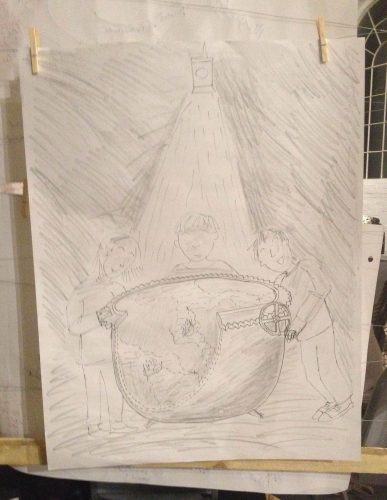 The large whaling pot sits at the entrance of the Museum of Iron. Through this simple but impressive object we wanted to bring visitors together to explore new sides of Coalbrookdale's history.
The large whaling pot sits at the entrance of the Museum of Iron. Through this simple but impressive object we wanted to bring visitors together to explore new sides of Coalbrookdale's history. Scenario
At the entrance of the Iron Museum sits a large cast iron whaling pot. This humble pot will become an interactive gateway to a dark story. A haunting voice, with sounds and projections, invites visitors to come closer, to peer into its depth and discover its story.
As the visitors look over the edge an atmospheric poem will begin. Visitors will discover the history of whaling, how the pot was used, why the animals were hunted and the importance of the trade within the global economy. Visually a stop motion animation will help transport the viewer to stormy seas and the hunt for blubber.
Intentions & Processes
We originally wanted to to use the pot to convey different stories including the significance of the technological change of using coke rather than charcoal, and for the visitors to be able to choose which story they heard. However, due to time constraints we decided to focus on one story.
The whale story became the focus partly due to the strong visual possibilities but also because the pot we wanted to use to tell the story was a whaling pot. Our audience would remain the same, they would be families and curious adults that we hope would gather around the pot to hear the story and possibly start a conversation.
By focusing on one story we avoided the issue of multiple users attempting to trigger multiple stories. We also did not have to consider how the stop/start mechanism would work, and could focus on a simple trigger for the audio and animation content. A worry had been how a project would look inside a black cast iron pot, but this seemed to be unfounded as it made a lovely textured surface.
Whilst writing the content we realised that a straight narrative was quite boring, even if it did come from a pot. This led us to try our hand at poetry. Poetry was useful as it was able to convey a lot of information in a short form and hopefully hold the visitors’ attention.
From the start we had wanted to use stop-motion animation, using our groups’ strengths in illustration. As the group worked on hand-drawn images that slowly became a film, we realised this worked really well.
To perform the poem we enlisted the help of Matthew Ward (@historyneedsyou). He not only made us a fantastic recording of the very simple poem we had written but also wrote and performed his own version – a beautiful and atmospheric poem that covers the same themes relating the pot to the history of whaling. You can hear Matthews audio at Audioboo.
Matthew Ward’s poem about the Coalbrookdale Whaling Pot
The whaling pot is large enough to allow a whole family to stand around its rim, so we have suspended a projector (thanks to Birmingham University who lent it to Museomix) from the ceiling, which will project images onto the interior of the pot. A sound amplifier is attached to the pot, turning it into a huge speaker.
The animation will be triggered by the arrival of visitors, who will activate a PI sensor. When no visitors are close, the pot will emit bubbling sounds, representing the rendering of whale blubber. When visitors enter the space, the pot will “speak”, inviting them to “Listen to my voice, gather round and hear my story, hark, and listen to me! Come closer, I have a story for you. Gather close but do not touch, for I am made of fire. Listen to my story of fire and oceans far.” When they arrive beside the pot, the animation, a stop motion representation of whaling, will be projected.
We hope the combination of closeness to the iron pot, which will be vibrating with sound, and with the animation, will both attract and grip the visitors, giving them a unique connection with what is after all, a humble utilitarian object, but which has a fascinating and rich story.
We hope that the same method of attracting interest and triggering a multimedia “label,” might be used on other iron pots scattered around the museum.
Hardware
We wanted to keep it as simple as possible.
Projection:
Paper, pens, scissors, iPhone with istop aapp, a projector, arduino, processing, PIR sensor, six laptops and a Mac Mini…
Audio: D1BT Bluetooth sound amplifier
Garage Band, Premiere
The help and advice from all the team, especially Dominic and the projector guy.
We can’t forget imagination and inspiration from the Coalbrookdale pot.


